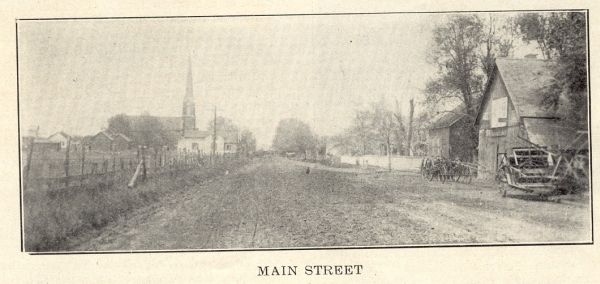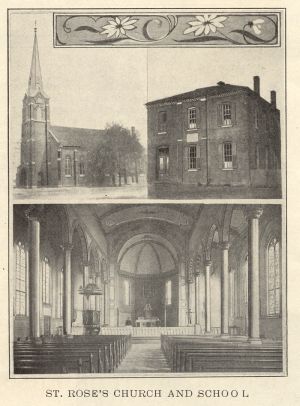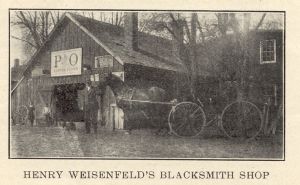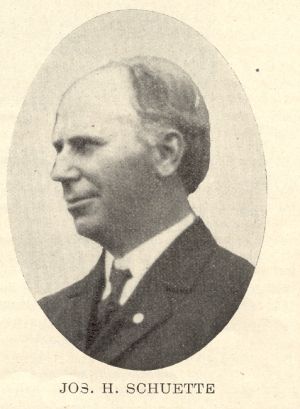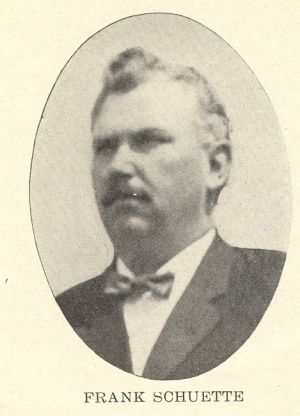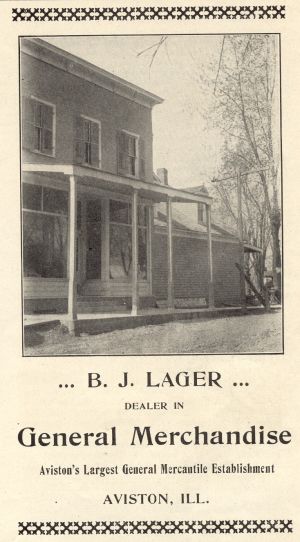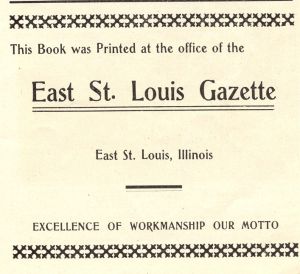|
Page 75 |
|
|
Blue Mound is a beautiful elevation in the prairie, on the northwest quarter of section 28. It can be seen for miles around. At its base is situated St. Rose Church, and around it are grouped the residences and business houses of St. Rose. The church was built in 1871. Previous to this a store building had been erected by Peter SCHUETTE, in 1870. He it was who secured the postoffice, and he was the first postmaster. He was a sturdy pioneer, coming here from Germany in 1857. Due to his enterprising nature was the development of this little village. |
out the order of divine services,and are a tribute to the faith and generosity of the member of St. Rose parish. The St. Rose Church has now a seating capacity of over 400 and is valued at $25,000.00. After the St. Rose’s Church had been built by a building committee appointed by the Rt. Rev. Bishop JUNKER, the parish was regularly attended monthly by Rev. MEGENER, of Collinsville, for more than a year. In May, 1870, Rev. Theo. KAMANN, of O’Fallon, Ill., was appointed Rector of St. Rose’s parish, which grew and prospered under his guidance to the present day. Upon the arrival of the first resident pastor a parsonage |
|
|
|
|
It now has a number of beautiful houses, several enterprising merchants, a blacksmith shop and wagonshop, and other industries. Among its attractions are its beautiful church, which is more fully described. St. Rose’s Parish The present parish of St. Rose forms the northwestern part of St. Rose township, which was originally and until recent times called Blue Mount. Its first Catholic settlers hailed from Switzerland and Baden, in the year 1814. A few years later new Catholic families came from Westphalia, Germany, and from the neighboring Catholic settlements of Germantown and St. Libory, Ill. These scattered people attended to their religious duties in Highland and Germantown, where churches had been built and services held ever since 1837. In 1858 the congregation of Breese was established, and its pastor, Rev. A. REINEKE, attended the scattered flock of Blue Mount township until, with the permission of the Rt. Rev. Bishop D. JUNKER, of Alton, the building of a church and the organization of a parish was planned and carried out in the year 1868. The new church, roman in style, was a solid brick building on a rock foundation 70 feet long and 51 feet wide. In 1892 this church was enlarged by an addition of 60 feet and fronted with a beautiful steeple 150 feet high, in which 3 harmonious bells ring |
was built of brick on a rock foundation, one-story high with a loft attic at the cost of $1,640.00. In 1908 this same parsonage was enlarged, a second story was built on it and interiorily the whole building was remodeled and equipped in up-to-date style, representing a value of $5,000.00. Already before the erection of a church the farmers of St. Rose township had built a little frame school room on the site of the present church property, to have their children taught by a Catholic school teacher. In the year 1881 a 2-story brick building was erected to serve as a school and as a Sisters’ dwelling for the future. In the fall of the same year two Sisters of the Precious Blood took charge of St. Rose’s school, and today 120 children are taught by a staff of three teachers of the above religious order. The societies affiliated with the parish are the Married Ladies’ Altar Society with 110 members, the Young Ladies’ St. Rose Society with 80 members, the Young Men’s St. Aloysius Society with 110 members, the St. Joseph’s Men’s Society with 80 members. The parish at present consists of 120 families and counts 700 souls. Ten girls have chosen the religious state and one boy has reached the sublime dignity of the priesthood. As soon as the first church had been finished in 1868, a nice piece of land north of the church property was secured for a cemetery, which received Episcopal |
|
Page 76 |
|
|
consecration in 1871, and was embellished with a solid stone cross in 1884. Rev. Theo. KAMANN, the first pastor of St. Rose, was born Nov. 4, 1844, at Westenfeld, near Essen, in the diocese of Paderborn, Germany. He studied at Paderborn and was ordained on the 19th of January, 1868 at O’Fallon, Ill. The young priest worked for over two years before his appointment as pastor of
St Rose. Rev. Wendelin GILLEN was assistant from 1894 until 1896. Rev. Bernard PETERS was assistant from 1896 to 1906. Rev. Jos. TRAGESSER from 1906 until November, 1912. Henry WEISENFELD Henry WEISENFELD was born August 8th, 1855, in a little village of Westphalia, Germany, and came to America in October, 1871, accompanied by his mother
and two brothers. They settled near Fayetteville, Ill., and there Henry learned the blacksmith trade. In 1875 he opened a shop of his own at Fayetteville and conducted |
same until 1877 he moved to St. Rose, where he built a shop and started a business. This shop was 20X24 feet. In 1890 he built an addition, since increasing business so necessitated. This commodious shop is now used for blacksmithing purposes, while a building to the rear, two stories in eighth and 30X36 feet in size, is used for wagon-making and storage house. Since 1909, Mr. WEISENFELD has carried a complete stock of P. & O. implements, Anchor buggies and Weber & Damme wagons. The topic of this sketch has always had an apprentice. Since 1903 his son, Henry, has assisted him, the latter now taking care of all blacksmithing, while the elder WEISENFELD takes care of the wagon repairs. They have worked up a fine and lucrative business, selling many implements, buggies and wagons, and are known for miles around for their exact and extraordinary good work. On September 6th, 1881, Mr. WEISENFELD was married to Miss Elizabeth JORDAN, of St. Rose, Illinois, which marriage was blessed with fourteen children, seven of whom are living. Five of these are at home with their parents, living in a cozy seven-room house adjoining their blacksmith and wagon shop at St. Rose. SCHUETTE Bros. Peter SCHUETTE, father of the above named, was born in Littstaedt, Germany, January 28th, 1838, and came to Washington county when 18 years of age. In 1869 he located on a farm southwest of St. Rose, and in 1870 started a store at St. Rose in a building which had formerly been a Methodist church at Shoal Creek. This building now serves as a warehouse. He continued in business excepting at short intervals. Jos. H. and Frank SCHUETTE, the present owners, started at the old stand in 1897. In 1902 they built the present quarters, 60X30 feet, comprising two floors, giving a floor space of 7,000 square feet. They have said space stocked to the limit at all times. Mr. George MUESENBROOK is clerk, and also has charge of the
produce department. Joseph ALBERTERNST does the freight hauling from the railroad station at Breese, Illinois, to St. Rose. The firm enjoys a large and extensive trade and high standing in the community. Their prices are as low as those of their competitors, quality considered. The trade has the satisfaction of having as good a market, and often a better, than any town along the railroads. Everything carried in a first class general store may here be found, including dry goods, notions, shoes, ranges and stoves, tailor-made clothing, groceries, harness, shelf hardware, sewing machines, woven and barb wire fencing, |
|
Page 77 |
|
|
carpets and linoleums, etc. The SCHUETTE Brothers were both born in St. Rose township and attended the Catholic school at St. Rose, also spent three years at college at Teutopolis, Illinois. Jos. H. SCHUETTE was born January 28th, 1873, while Frank SCHUETTE’s date of birth is May 14th, 1877. After returning from college both boys stayed with their widowed mother in retired life until they reopened the general store at the above date. Jos. H. SCHUETTE is School Treasurer of St. Rose township and
owns 400 acres of improved farms in Clinton and Madison county. Jos. H. also owns 560 acres of farm property in Ford county, Kansas. He was married to Elizabeth PETERMEYER, of Breese, Ill., May 13th, 1903. He has four children, two girls and two boys and resides in a pretty little home just north of the store property. Frank SCHUETTE is director in the State Bank of Breese, Illinois; has 100 acres of land in East St. Louis, Ill., and 3,600 acres of improved farms in Harper, Barber and Ford, Kansas. On April 23rd, 1912, he was married to Miss Caroline LUBER, of Highland, Illinois, and now resides in a home east of the store with his wife and her parents. PEACE CONFERENCE. A writer in the Richmond (Va.) Times-Dispatch says: Preparations are now being made in Europe for the next international Peace conference at The Hague, which takes place two years hence - that is to say, in the summer of 1915. Preliminary meetings have already been held in Paris, Rome and St. Petersburg, as well as in London, for the purpose of formulating proposals for consideration at the conference through the respective governments taking part therein. Those in London have been presided over by Lord Loreburn, who was lord high chancellor until a year ago, and attended by Lord Avebury, the banker, formerly known as Sir John Lubbock; Sir Earnest Satow, for so many years British envoy at Peking and Tokio, and Sir John Macdonald, master of the supreme court for Great Britain for the last quarter of a century, and one of the leading authorities in England on international and mercantile law. Lord Loreburn's conference appointed two subcommittees - one to deal with all matters relating to naval warfare, including the abolition of the right of private capture at sea, blockade and contraband, while the other committee will consider all questions outside those affecting naval warfare. The falling off in production of wheat per capita was counterbalanced by a decrease in the amount exported. |
|
This file last modified
